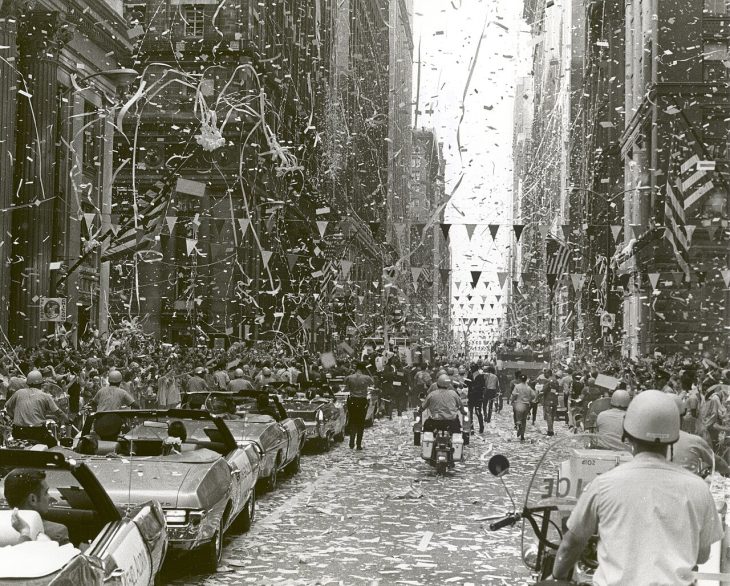
Word of the Day: Confetti
December 30 Confetti
Today’s Word of the Day, thanks to the Dictionary Project, is confetti, a noun which means “small pieces of colorful paper thrown or dropped from overhead during a celebration,” but of course you knew that. Interestingly, though, it has a second definition: “confections; bonbons” (https://www.dictionary.com/browse/confetti). Wait, what? How does it mean that? Let’s check the etymology.
According to etymonline, confetti first appears in English in 1815 and referred to “’small pellets made of lime or soft plaster, used in Italy during carnival by the revelers for pelting one another in the streets,’ from Italian plural of confetto ‘sweetmeat,’ via Old French, from Latin confectum, confectus” (https://www.etymonline.com/search?q=confetti). The entry continues, “The little balls (which left white marks) were substitutes for the small sugar-plum candies that traditionally were thrown during Italian carnivals; the custom was adopted in England by early 19c. for weddings and other occasions, with symbolic tossing of little bits of paper (which are called confetti by 1846).”
So the little pieces of paper are linguistically and historically related to sweets. That seems appropriate for a holiday like New Year’s Eve.
In honor of its nearly being New Year’s Eve, today I’m going to share with you some interesting tidbits about this holiday.
First, the New Year has not always started on January 1st. It used to be March 1st. But then Julius Caesar created a new, more accurate calendar, and he made January the first month of the year, which oddly made September, October, November, and December, which had been the seventh, eighth, ninth, and tenth months of the year, into the 9th through 12th months, despite their names. One “reason behind making January 1 the start of the New Year was to honor Janus — the Roman god of beginnings who had two faces. This means that he could go back to the past and move forward to the future” (https://resolutiondenver.com/history-of-new-years-eve/).
One of the oldest traditions for the new year was the giving of gifts. According to The Holiday Spot (https://www.theholidayspot.com/newyear/gifts.htm), Celtic druids used to give mistletoe as a present on New Year’s. The Romans had a similar tradition, giving branches from sacred trees, which they called strenae after the goddess Strenia, the goddess of luck. Later on, the English, Scots, and French all participated in the tradition of giving gifts on New Year’s Day.
Another tradition for New Year’s Eve and New Year’s Day is the eating of certain foods. In Spain, you eat twelve grapes at midnight, one on each stroke of the clock, one for each month of the coming year, if you want to have a good year. In some countries, you eat a round cake—round perhaps represents the circle of life. In some countries, you eat pork because, for some reason, pigs represent progress; I imagine that Israel and Saudi Arabia are not in that group of countries. In “Japan, people eat soba noodles on NYE to symbolize their journey from the old year to the new one. This also means leaving behind their regrets in the last year.”
In some Latin American countries, people choose a color of underwear to match their aspirations for the coming year. In some Germanic countries, a midnight kiss promises good luck in the coming year. Fireworks, throwing water out a window, having a toast, and, at least in Scotland, singing “Auld Lang Syne” are some other traditions.
If I could change one thing about how we, at least in the USA, celebrate the midwinter holidays, it would be to return to the tradition of gift giving on New Year’s Day instead of on Christmas Day. I know that that would be impossible, but if we were to make that change, it would restore some of the Christianity to Christmas. Unfortunately, there are far too many stories, poems, songs, and movies that connect the gift giving to Christmas. Oh, well.
Today’s image is of a “Ticker-tape parade in Chicago in 1969 for the Apollo 11 astronauts” (https://en.wikipedia.org/wiki/Ticker-tape_parade#/media/File:Chicago_Welcomes_the_Apollo_11_Astronauts_(9457411063).jpg). The original ticker tape parades (a tradition that began in the 19th century in New York City) used actual ticker tape, but after a while confetti was substituted for the ticker tape. The name, however, was not changed.